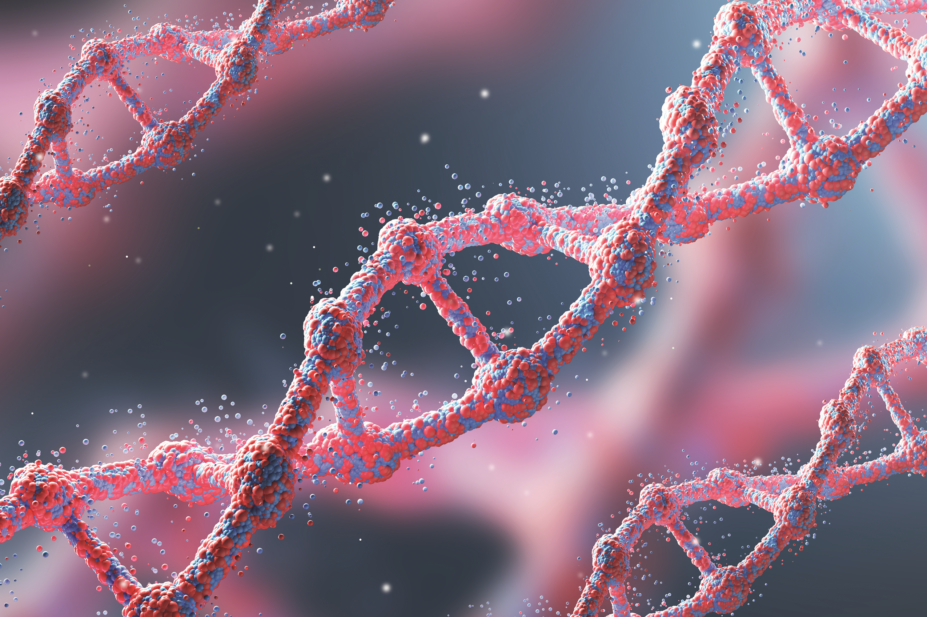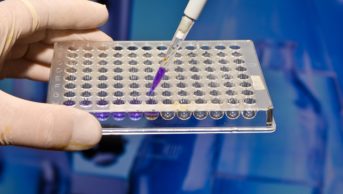
Shutterstock.com
The
Telegraph described it as “the biggest advance in cancer practice for 20 years”;
The Guardian said: “Thousands of breast cancer patients could avoid chemo”; and The Daily Mirror hailed it as a “major coup for the NHS”. The Trial Assigning IndividuaLized Options for TReatment (Rx) — known as TAILORx — has made waves since being presented at the American Society of Clinical Oncology 2018 Annual Meeting in Chicago on 3 June 2018, and with good reason[1]
.
TAILORx’s focus — breast cancer — remains the most common cancer to affect women and the second leading cause of death in women in the UK and the United States[2]
,[3]
.
The TAILORx study looked at the most common form of breast cancer — hormone receptor (HR)-positive/human epidermal growth factor receptor 2 (HER2)-negative, axillary node (AN)-negative, breast cancer — which accounts for roughly half of all cases of the disease. Sparano et al. conducted the phase III prospective trial federally funded by the US National Cancer Institute[1]
. The trial involved 10,273 women aged 17–75 years between 2006 and 2010. All women received Oncotype DX testing, which predicted their risk of cancer recurrence within ten years.
Before TAILORx, half of all new cases of breast cancer (over 266,000 in the United States and 54,900 in the UK) receive chemotherapy, a treatment with adverse effects such as vomiting, nausea, fatigue, hair loss, neuropathy and, in younger women, early menopause or infertility. But results from TAILORx suggest that 70% of these women could be spared chemotherapy, and by using the genomic test Oncotype DX to guide decision-making, less than 30% of these women might need chemotherapy.
Harnessing genetics
Oncotype DX, developed by California-based genetic research company Genomic Health, analyses a tumour sample for the activity of 21 genes that can affect how a tumour is likely to behave in response to a particular treatment.
Women eligible for Oncotype DX testing include those recently diagnosed with stage I or II invasive breast cancer; those in whom the tumour is oestrogen receptor (ER)-positive, AN-negative and those whom, with their consultant, are considering chemotherapy. Women recently diagnosed with ductal carcinoma in situ (DCIS) or having lumpectomy to remove the DCIS may also be candidates. After surgery, women can reduce the risk of recurrence by taking selective estrogen receptor modulators (SERMs), such as tamoxifen[4]
,[5]
, or aromatase inhibitors, such as exemestane, letrozole and anastrozole[6]
.
The Oncotype DX provides a recurrence score (RS): a number from 0–100[7]
. An RS of less than 18 means the tumour has a low risk of recurrence and the benefits of chemotherapy are unlikely to outweigh the adverse effects. An RS ≥18 and ≤30 means the tumour has an intermediate risk of recurrence and it is unclear whether chemotherapy exerts benefits. An RS ≥31 means the tumour has a high risk of recurrence and the benefits of chemotherapy are likely to outweigh the adverse effects.
Evidence base
Crolley et al. reported that interpretation of the scores of intermediate risk of recurrence and the subsequently offered chemotherapy regimens has the widest variation in practice in the UK[8]
. Loncaster et al. reported that capitalising on Oncotype DX in women with AN-negative and positive breast cancer significantly reduces the use of chemotherapy (P <0.001) and its associated morbidity and costs[9]
. Furthermore, Holt et al. reported that reconsidering chemotherapy based on Oncotype DX results was associated with improvements in survival and quality-adjusted life expectancy in the UK[10]
.
Gluz et al. reported a trial that included 3,198 women (median age 56 years) with HR-positive, HER2-negative, AN-positive or high-risk node-negative early breast cancer (median follow-up of 35 months), from 2009–2011[11]
. The study recommended women with an RS ≤11 to abstain from adjuvant chemotherapy. The three-year disease-free survival for the 348 patients not treated with chemotherapy with an RS ≤11 was 98%.
In light of the TAILORx trial, around 5,000 women could be spared the harmful implications of chemotherapy each year
Stemmer et al. conducted a clinical analysis of 1,801 women (median age 60 years) with ER-positive, HER2-negative pN0-1 breast cancer (median follow-up of 6.2 years) from 2006–2010[12]
. In patients with an RS <18, the five-year risk of distant recurrence (where the cancer has spread to a region away from where the original cancer was located) was low. The rate of breast cancer-related death was also low. Endocrine therapy (ET) alone is supported in this group of patients. In addition, in women not treated with chemotherapy with an RS 11–25, the five-year distant recurrence rates were very low; chemotherapy is unlikely to exert clinical benefit in this group of patients.
TAILORx: the landmark trial
Of the 10,273 women who took part in the TAILORx trial, 6,711 had a mid-range an RS of 11–25 and were randomly assigned to receive either ET alone (most commonly tamoxifen for pre-menopausal women, and most commonly aromastase inhibitors for post-menopausal women) or chemoendocrine therapy (CET, most commonly taxane and cyclophosphamide). The primary end point was disease-free survival (recurrence of cancer in the breast, regional lymph nodes and/or distant organs, a second primary cancer in the opposite breast or another organ, or death from any cause).
At a median follow-up of 7.5 years, ET in women with a mid-range RS of 11–25 was not inferior to CET. Simply, this patient group would not benefit from chemotherapy and ET is as effective while less toxic and cheaper.
TAILORx will improve the lives of women who present with breast cancer
Women with RS ≥26 had a distant recurrence of 13% despite having chemotherapy and ET. Women with an RS <10 had very low recurrence rates with ET alone, regardless of age or other clinical variables. Women aged ≤50 years with an RS of 16–25 were shown to have some benefits from chemotherapy.
TAILORx’s global financial and health benefits
In light of the TAILORx trial, around 5,000 British women in the UK could be spared the harmful implications of chemotherapy each year and the NHS could also be spared the financial burden; chemotherapy currently costs the NHS around £4,500 per patient.
Oncotype DX is available to the NHS for a subsidised rate of around £2,580 per patient[13]
and is available in the United States for around US$3,000 per patient[14]
. As for ET, five years of tamoxifen treatment — much less toxic, relatively — would cost around 6p per patient per day, per patient and only £109.50–£130.00 over five years[15]
. In the UK, anastrozole costs around 7p per day per patient[16]
and only £127.75 over five years. One estimate shows that if British women were to adhere to five years of tamoxifen treatment, 500 more lives could be saved a year, and £30m more could be saved in the NHS budget a year[17]
. In 2006, Lønning reported that two to three years of tamoxifen followed by an aromastase inhibitor provided the lowest estimates of cost and highest number of quality-adjusted life years[18]
.
Personalised treatment
TAILORx will improve the lives of women who present with breast cancer. Its beauty lies in its reversion to a principle of cancer care: let the prognostic and/or predictive tests guide the treatment plan. The trial has encouraged the scientific and medical community to see precision medicine in a new light, which shines on treatments targeted to the correct patient populations, not only to the correct cellular targets. What our patients deserve is best described in the words of Roman emperor and stoic philosopher Marcus Aurelius: “Life is not merely being alive, but being well.” TAILORx is helping to foster that notion.
Balkees Abderrahman, postdoctoral fellow, University of Texas MD Anderson Cancer Center, United States; PhD candidate, University of Leeds, UK. Correspondence to: bhabderrahman@mdanderson.org
References
[1] Sparano JA, Gray RJ, Makower DF et al. Adjuvant chemotherapy guided by a 21-gene expression assay in breast cancer. N Engl J Med 2018 (Epub ahead of print). doi: 10.1056/NEJMoa1804710
[2] Cancer Research UK. Breast cancer statistics. Available at: http://www.cancerresearchuk.org/health-professional/cancer-statistics/statistics-by-cancer-type/breast-cancer (accessed June 2018)
[3] American Cancer Society. Breast cancer: facts and figures 2017–2018. Available at: https://www.cancer.org/research/cancer-facts-statistics/breast-cancer-facts-figures.html (accessed June 2018)
[4] Jordan VC. Tamoxifen as the first targeted long-term adjuvant therapy for breast cancer. Endocr Relat Cancer 2014;21(3):R235–R246. doi: 10.1530/ERC-14-0092
[5] Jordan VC. Linking estrogen-induced apoptosis with decreases in mortality following long-term adjuvant tamoxifen therapy. J Natl Cancer Inst 2014;106(11):dju296. doi: 10.1093/jnci/dju296
[6] Jordan VC & Brodie AM. Development and evolution of therapies targeted to the estrogen receptor for the treatment and prevention of breast cancer. Steroids 2007;72(1):7–25. doi: 10.1016/j.steroids.2006.10.009
[7] Klein ME, Dabbs DJ, Shuai Y et al. Prediction of the oncotype DX recurrence score: use of pathology-generated equations derived by linear regression analysis. Modern Pathol 2013;26(5):658–664. doi: 10.1038/m odpathol.2013.36
[8] Crolley VE, Marashi H, Rawther SKR et al. The impact of Oncotype DX breast cancer assay results on clinical practice: A UK experience. Ann Oncol 2017;28(Suppl 5):v43–v67. doi: 10.1093/annonc/mdx362
[9] Loncaster J, Armstrong A, Howell S et al. Impact of oncotype DX breast recurrence score testing on adjuvant chemotherapy use in early breast cancer: real world experience in Greater Manchester, UK. Eur J Surg Onc 2017;43(5):931–937. doi: 10.1016/j.ejso.2016.12.010
[10] Holt S, Bennett H, Bertelli G et al. Cost-effectiveness evaluation of the oncotype DX(R) breast cancer assay in clinical practice in the UK. Cancer Research 2012;71(24). doi: 10.1158/0008-5472.SABCS11-PD06-02
[11] Gluz O, Nitz UA, Christgen M et al. West German Study Group Phase III PlanB Trial: first prospective outcome data for the 21-gene recurrence score assay and concordance of prognostic markers by central and local pathology assessment. J Clin Oncol 2016;34(20):2341–2349. doi: 10.1200/JCO.2015.63.5383
[12] Stemmer SM, Steiner M, Rizel S et al. Clinical outcomes in patients with node-negative breast cancer treated based on the recurrence score results: evidence from a large prospectively designed registry. NPJ Breast Cancer 2017;3:33. doi: 10.1038/s41523-017-0034-6
[13] National Institute for Health and Care Excellence. Gene expression profiling and expanded immunohistochemistry tests for guiding adjuvant chemotherapy decisions in early breast cancer management: MammaPrint, Oncotype DX, IHC4 and Mammostrat. Available at: https://www.nice.org.uk/guidance/dg10/chapter/5-outcomes (accessed July 2018)
[14] Breastcancer.org. Study looks at cost-effectiveness of Oncotype DX DCIS test. Available at: https://www.breastcancer.org/research-news/oncotype-dx-dcis-test-cost-effectiveness (accessed July 2018)
[15] Roberts M. Breast cancer: NHS to offer tamoxifen to at-risk women. BBC News 25 June 2013. Available at: https://www.bbc.co.uk/news/health-23032371 (accessed June 2018)
[16] Willey J. Scandal as 7p breast cancer preventing drug is overlooked by NHS. The Daily Express 29 September 2014. Available at: https://www.express.co.uk/news/uk/516453/NHS-overlook-cheap-cancer-preventing-drug (accessed June 2018)
[17] Breast Cancer Campaign. 500 lives and £30 million a year could be saved if patients are better supported to follow guidance on tamoxifen UK. Available at: https://www.gla.ac.uk/media/media_288921_en.pdf (accessed June 2018)
[18] Lønning PE. Comparing cost/utility of giving an aromatase inhibitor as monotherapy for 5 years versus sequential administration following 2–3 or 5 years of tamoxifen as adjuvant treatment for postmenopausal breast cancer. Ann Oncol 2006;17(2):217–225. doi: 10.1093/annonc/mdj048


